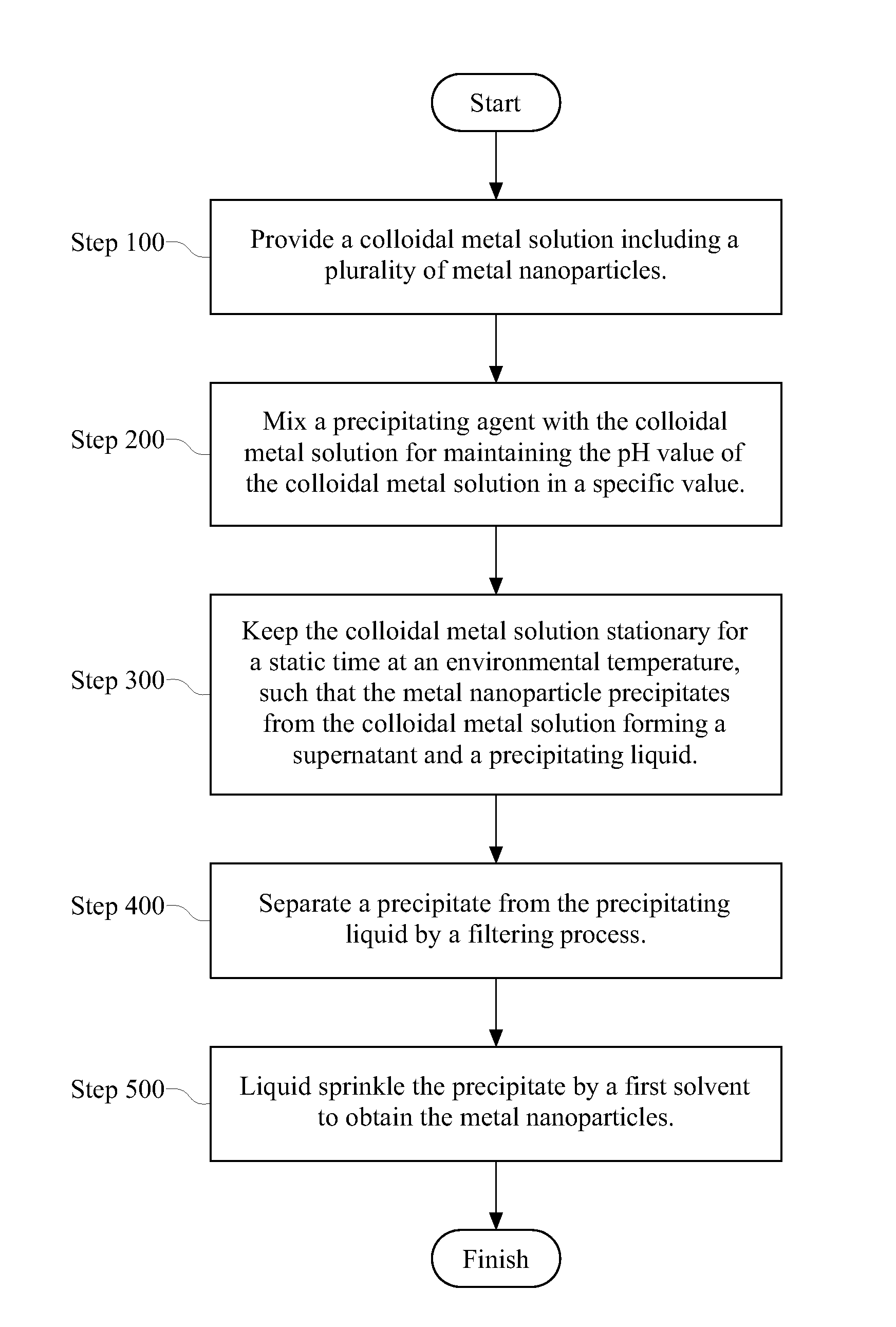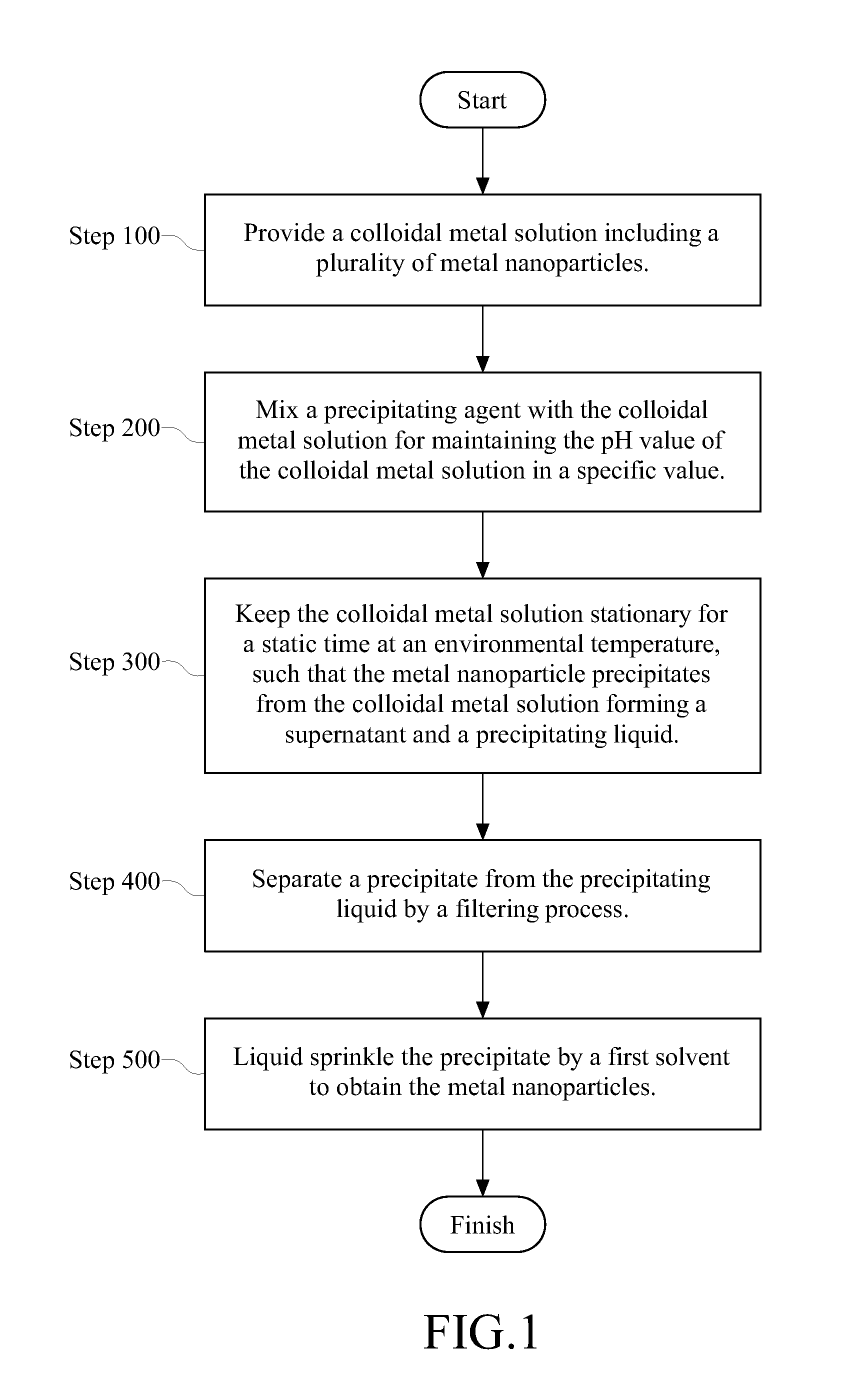Method for separating metal nanoparticles from colloidal metal solution
a metal nanoparticle and colloidal metal technology, applied in the field of separation, can solve the problems of high cost, inability to obtain a particle with a diameter less than 100 nanometers (nm), and inability to use colloidal nano-ag solution in some applications directly
- Summary
- Abstract
- Description
- Claims
- Application Information
AI Technical Summary
Benefits of technology
Problems solved by technology
Method used
Image
Examples
first embodiment
The First Embodiment
[0024]First, a first solution is formed. 49 grams (g) of polyvinylpyrrolidone (PVP) with molecular weight of 58,000 is provided to be dissolved in 240 milliliters (ml) of deionized water. Next, 0.96 g of sodium hydroxide and 21.6 g of glucose are mixed with deionized water in sequence. In addition, a second solution is also formed. 10.2 g of silver nitrate is provided to be dissolved in another 120 ml of deionized water. Then, 48 g of urea is mixed with the deionized water. The first and second solutions are mixed with each other, and then, the mixed solution is stirred sufficiently. After stirring, the mixed solution is immediately moved to a thermostatic bath with 30° C. and is reacted in 60 minutes. That is, a colloidal nano-Ag solution is obtained. The average diameter of the colloidal nano-Ag solution is 52 nm measured by a particle size measurement device (in this embodiment, the particle size measurement device is Malvern (brand name), Zetasizer 3000HS (pr...
second embodiment
The Second Embodiment
[0025]First, a first solution is formed, which is the same as the first embodiment. 49 g of PVP with molecular weight of 58,000 is provided to be dissolved in 240 ml of deionized water. Next, 0.96 g of sodium hydroxide and 21.6 g of glucose are mixed with deionized water in sequence. In addition, a second solution is also formed. 5.1 g of silver nitrate is provided to be dissolved in another 120 ml of deionized water. Then, 48 g of urea is mixed with the deionized water. The first and second solutions are mixed with each other, and the mixed solution is immediately moved to a thermostatic bath with 30° C. and is reacted in 60 minutes. That is, a colloidal nano-Ag solution is obtained. The average diameter of the colloidal nano-Ag solution is 9 nm. The colloidal nano-Ag solution includes not only nano-Ag particles but also excess unreacted glucose, PVP and dissolved impurities, such as nitrate, hydroxyl and amino. Therefore, the impurities must be removed so that...
third embodiment
The Third Embodiment
[0032]First, a first solution is formed by a copper sulfate solution. An adequate amount of copper sulfate is provided to form the 250 ml copper sulfate solution with 0.1 mol / L (liter). Next, a second solution is formed by a sodium hypophosphite solution. 20 g of PVP with molecular weight of 58,000 is provided to be dissolved in 150 ml of deionized water. Next, 25 g of the sodium hypophosphite is mixed with the deionized water. The first and second solutions are mixed with each other, and then, the mixed solution is stirred sufficiently. Next, the mixed solution is immediately moved to a thermostatic bath with 95° C. and is reacted in 60 minutes. That is, a colloidal nano-Cu solution is obtained. The average diameter of the colloidal nano-Cu solution is 85 nm measured by the particle size measurement device (in this embodiment, the particle size measurement device is Malvern (brand name), Zetasizer 3000HS (product name), but is not limited to the above-mentioned ...
PUM
| Property | Measurement | Unit |
|---|---|---|
| static time | aaaaa | aaaaa |
| temperature | aaaaa | aaaaa |
| temperature | aaaaa | aaaaa |
Abstract
Description
Claims
Application Information
 Login to View More
Login to View More - R&D
- Intellectual Property
- Life Sciences
- Materials
- Tech Scout
- Unparalleled Data Quality
- Higher Quality Content
- 60% Fewer Hallucinations
Browse by: Latest US Patents, China's latest patents, Technical Efficacy Thesaurus, Application Domain, Technology Topic, Popular Technical Reports.
© 2025 PatSnap. All rights reserved.Legal|Privacy policy|Modern Slavery Act Transparency Statement|Sitemap|About US| Contact US: help@patsnap.com


